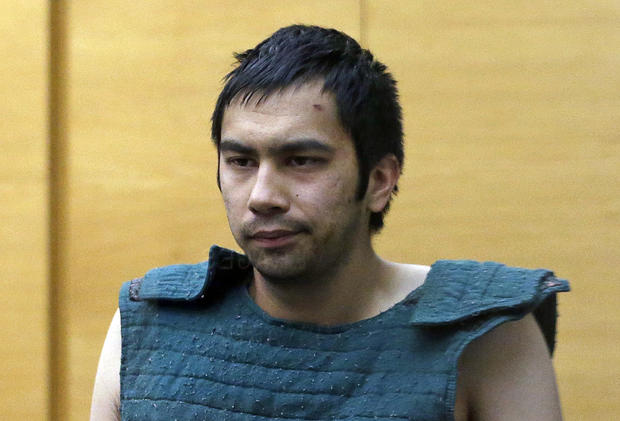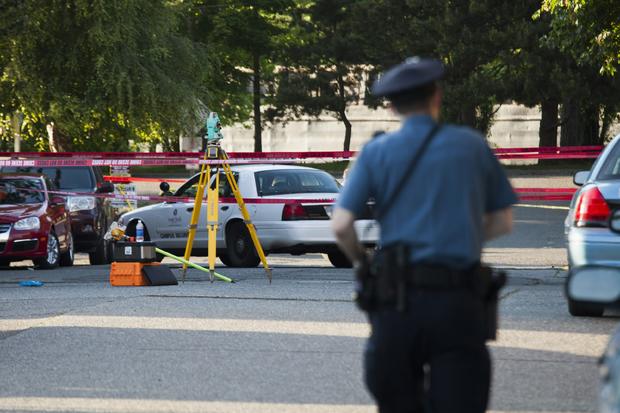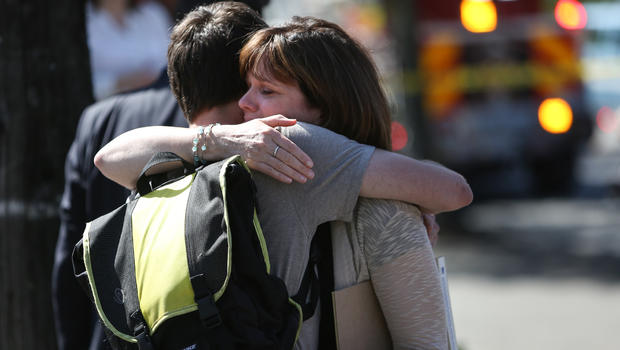Seattle shooting suspect had mental health evaluations
SEATTLE -- Police say the suspect in a shooting at a small Seattle university was hospitalized twice in recent years for mental health evaluations.
Pete Caw is the assistant police chief in the suburb of Mountlake Terrace, where the suspect, Aaron Ybarra, lives. He said Friday that officers encountered Ybarra in 2010 and 2012.
Caw says both times, Ybarra was severely intoxicated and taken to Swedish Hospital in Edmonds for evaluation. In the October 2012 incident, police found him lying in a roadway.
Ybarra was arrested in the killing of a 19-year-old student and wounding of two other young people Thursday at Seattle Pacific University. Police say another student pepper-sprayed and tackled him.
The 26-year-old Ybarra has been booked for investigation of homicide and is scheduled to make a court appearance Friday afternoon.
At an earlier news conference, Assistant Police Chief Paul McDonagh said the man in custody was not a student at the school.
The afternoon shooting came a week before the end of the school year, and the situation was particularly tense when police initially reported that they were searching for a second suspect.
"It appears the suspect acted alone," McDonagh said. Initially, "There was a report of another person with a weapon, but (investigators) have not confirmed that."
He said he did not know the gunman's motive or intended target. Detectives are "working as quickly as we can to figure it out," McDonagh said.
Seattle polilce said in a statement late Thursday that they hadn't "found any connection between the suspect, Seattle Pacific University or any of the victims."
Ybarra was obsessed with the Columbine High School shootings and had even traveled to the Colorado site where two student gunmen killed 15 and injured another 21 fellow students in April 1999, police sources told CBS Seattle affilitate KIRO-TV.
Also late Thursday, police who said they were serving a warrant entered a house that was believed tied to Ybarra. A phone message left at that house in a north Seattle suburb was not immediately returned.
The university locked down its campus for several hours, and it alerted students and staff to stay inside. Some students were taking finals in the same building that the shooter entered.
"There are a number of heroes in this," McDonagh said. "The people around him (the gunman) stepped up."
Multiple shots were fired, and the gunman had additional rounds, McDonagh said.
"But for the great response by the people of Seattle Pacific, this incident might have been much more tragic," he said.
KIRO reports that fellow students identified the student who used the pepper spray as Jon Meis, an electrical engineering student, though police have not confirmed Meis' name. KIRO says Meis was volunteering at the Otto Miller Hall security desk.
Both the young man who died and the young woman suffered gunshot wounds to the body, Seattle Fire Assistant Chief Jay Hagen told the news conference.
On Thursday evening, people packed the First Free Methodist Church on campus for a service of prayers and song. So many people crowded into the building that dozens of people gathered on a lawn near the church and formed their own groups as the sun set.
"We're a community that relies on Jesus Christ for strength, and we'll need that at this point in time," said Daniel Martin, president of Seattle Pacific University.
About 4,270 undergraduate and graduate students attend the private Christian university. Its 40-acre campus is in a leafy residential neighborhood about 10 minutes from downtown Seattle. The school canceled classes and other activities Friday.
Jillian Smith was taking a math test on the second floor of Otto Miller Hall when a lockdown was ordered.
She heard police yelling and banging on doors in the hallway. The professor locked the classroom door, and the 20 or so students sat on the ground, lining up at the front of the classroom.
"We were pretty much freaking out," said Smith, 20, a sophomore. "People were texting family and friends, making sure everyone was OK."
About 45 minutes later, police came and escorted them out of the building two by two, she said. On the way, they passed the lobby where she saw bullet casings and what appeared to be blood in the lobby carpet and splatter on the wall.
"Seeing blood made it real," Smith said. "I didn't think something like this would happen at our school."
Ashley Springer, 26, was in a classroom with her professor and a few other students when a woman with a bullhorn came into the room and told them to lock the door, pull down the shades and turn out the lights.
Springer, a senior, called Seattle Pacific University "a really close community."
David Downs, a 22-year-old senior who is graduating next week, said he left campus 30 minutes before the shooting.
"I'm in utter shock," said Downs, who is a point guard on the university's basketball team. "It's so unbelievable to me that this could happen on our campus. It's the last thing I would have ever thought could happen here."
"It puts things in perspective," he said. "Anything can happen, even on a small Christian campus."
The gun violence follows a spate of recent shootings on or near college campuses.
Last month, according to police, Elliot Rodger killed six people and injured seven before turning his gun on himself in a rampage in Isla Vista, California, near two universities.
Seven people were killed and three injured when a 43-year-old former student opened fire at a tiny Christian school, Oikos University, in Oakland, California, in 2012. A gunman killed five people and injured 18 when he opened fire in a Northern Illinois University lecture hall in 2008.
In 2007, 32 people were fatally shot in a dorm and classroom at Virginia Tech in Blacksburg, Virginia, before the gunman killed himself.
Seattle Mayor Ed Murray, noting previous mass shootings in the city, said, "Once again, the epidemic of gun violence has come to Seattle."



